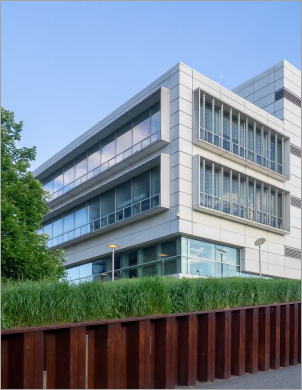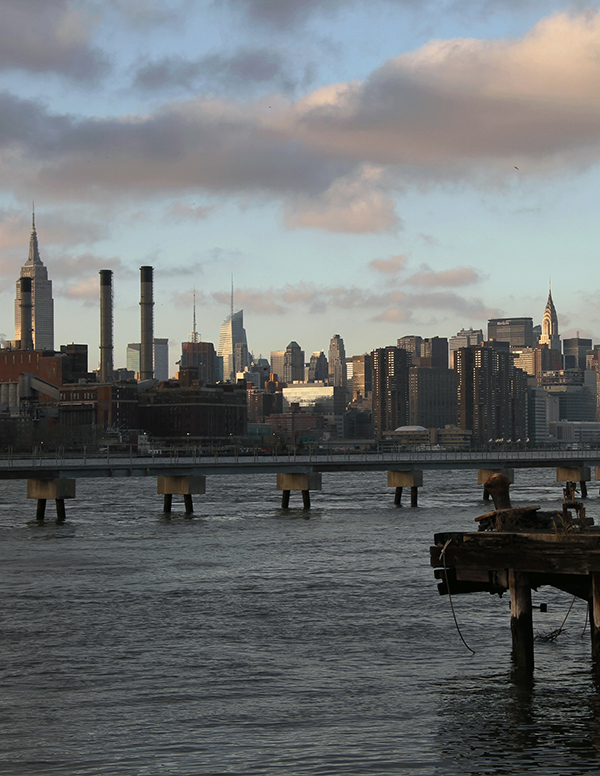Meeting New York City’s ambitious climate goals will require a massive retrofit of its buildings, which make up almost 70 percent of the city’s carbon footprint. But even as policies including Local Law 97 push privately owned buildings to go green, New York City’s largest property owner, the City of New York, will have to make major strides as well.
A 2022 data brief from the Center for an Urban Future found that city government has made headway in recent years, reducing emissions intensity—or total carbon emissions by ground square footage—of its facilities by 10 percent since 2014. But much more progress will be needed in the years ahead to achieve the city and state’s climate agenda, starting with one key part of the portfolio: the City University of New York (CUNY).
While making this progress will require ample new investment, doing so won’t just help the city reduce carbon emissions and prepare for climate change. It will also help CUNY upgrade its aging building stock, which will strengthen and modernize an institution that is the city’s most important economic mobility institution, but sadly, also home to an alarming number of campus buildings in various states of disrepair that are failing the university’s mostly low-income students.
New York City should leverage unprecedented state and federal resources to make a generational investment in the university’s net-zero future—and put CUNY students to work achieving this.
There’s a lot of work to do. CUNY is home to 25 colleges spread across nearly 300 buildings and over 29 million ground square feet—or the total of 353 Empire State Buildings. The majority of CUNY’s buildings are over 50 years old and reliant on gas- and oil-fired boilers for heat in the cold months and window air conditioners for cooling as temperatures rise. Most buildings are equipped with their original single-pane glass windows, insufficient or nonexistent insulation, and lighting and other fixtures that consume far more resources than modern alternatives.
To be clear, CUNY has made some progress in recent years with the limited funding available. According to CUNY’s own data, its seven community colleges reduced emissions intensity by 17 percent from 2014 to 2019—keeping pace with the goals set of other city-owned buildings. However, emissions intensity among CUNY’s 11 senior colleges, which make up the bulk of the system’s physical footprint, barely budged between 2014 and 2019.
Meeting the city and state’s commendable targets for carbon emission reduction—40 percent by 2030, and 80 percent by 2050—will be all but impossible without a major new focus on helping decarbonize CUNY.
This month’s City Council budget hearing primarily focused on restoring cuts to CUNY’s operating expenses. But less attention was paid to the 24 percent cut to capital funding for CUNY, which was already woefully insufficient to keep pace with basic infrastructure needs, let alone help dramatically slash the system’s carbon footprint. Over the past five years, CUNY has received $2.9 billion from the state and $500 million from the city to renovate and upgrade its facilities. Yet its next five-year capital plan calls for $5.44 billion—almost double that amount—based on core infrastructure needs that the university has identified.
According to CUNY’s FY 2025 budget request, only about 8 percent of CUNY buildings are in a state of good repair. The average score for facility condition is an abysmal 10 percent. The system still faces a deferred maintenance backlog of $4.3 billion, with an additional $2.5 billion needed for ongoing renewal. And students see that shortfall on a regular basis. As of early 2024, four out of 34 buildings on the campus of Bronx Community College were closed due to disrepair. Meanwhile, Hunter College has seen a succession of pipe bursts, water leakages, and infestations—at one point, there was even a student-led social media account documenting the deterioration.
Now is the time to act. The Biden administration’s climate and infrastructure bills have catalyzed billions in new funding for building retrofits. The state’s Environmental Bond Act, overwhelmingly passed by New Yorkers in late 2022, will unlock $4.2 billion for climate mitigation projects, including building electrification and green infrastructure.
To seize this opportunity, Mayor Adams should work with Albany and Washington on a major new campaign to create a far greener CUNY system by 2030, making the nation’s largest urban public university system the centerpiece of the public green transition.
CUNY has already taken encouraging steps, even absent sufficient long-term capital allocations. The Sustainable CUNY initiative has drafted strategies around everything from renewable energy and efficiency upgrades to resiliency planning and recycling. Its CUNY Conserves effort shares best practices around energy consumption in building operations, with a modest revolving fund to help support small projects. A handful of new campus buildings coming online are LEED-certified—far exceeding the efficiency of the system’s older buildings. Borough of Manhattan Community College is home to the largest public solar project in Manhattan, City College is working to develop the next generation of advanced heat pump systems, and Bronx Community College is in the final stages of installing upgraded boiler and chiller systems with support from the New York Power Authority.
Even without sufficient resources, CUNY has demonstrated a commitment to making progress on climate change. After a pandemic-induced lull, the system’s carbon emissions continued to drop in 2022 and 2023. CUNY has developed a smart five-year plan to get on track to meet its climate goals, but it lacks the resources to see it through. For instance, CUNY’s own Sustainable Investment Fund for campus energy projects only allocates about $1 million annually across 25 campuses—a tiny fraction of the need.
City Hall and Albany share ambitious targets for greenhouse gas reduction, as well as joint fiscal responsibility for CUNY. Achieving New York’s climate goals will require Governor Hochul and Mayor Adams to work together on a plan to invest in a greener future for CUNY.
Fortunately, this effort has a secret weapon: CUNY itself. The CUNY Building Performance Lab serves as a hands-on research center for New York’s decarbonization efforts, helping buildings come into compliance with Local Law 97, lending out devices to track carbon emissions, and providing paid internships for students interested in green building careers. City College’s Grove School of Engineering has cutting-edge renewable energy and building electrification research centers, while four colleges now participate in the CUNY Climate Scholars program. Students can earn degrees and certifications in everything from clean energy HVAC to solar power to sustainability in the urban environment.
With sufficient investment, New York City and State could mobilize the immense talent and knowledge already at CUNY to build a greener and more resilient university across the five boroughs. These CUNY-wide decarbonization efforts could double as the real-world training students need today to access the well-paying green jobs of tomorrow.
Promising models are emerging on campus. In 2022, The Fund for Public Housing partnered with NYCHA, LaGuardia Community College, and other funders to create the NYCHA Clean Energy Academy, a program in which cohorts of public housing residents connect with NYCHA contractors to learn solar installation, heat pumps, and HVAC upgrades. The program aims to train 100 residents over two years, placing almost two-thirds into clean energy jobs. Additionally, Bronx Community College was awarded $1 million from the Bronx Economic Development Corporation to launch the BCC Sustainability Hub, which will work with students to build rain gardens, expand recycling and composting programs, reduce water usage, and provide solar and wind turbine training. Most recently, the city’s Economic Development Corporation (NYCEDC) announced $10 million in capital investments for CUNY campuses, as part of its Green Action Plan.
But these models remain small-scale and limited in scope. What's needed now is a public, university-wide investment that enables CUNY to level up decarbonization efforts and connect them to classroom and hands-on learning.
The next steps are clear. First, Mayor Adams should launch a major new initiative to build a greener CUNY and identify CUNY as a key target for incoming federal and state funding. Second, the Adams and Hochul administrations should work together to boost CUNY capital investment in the upcoming budget cycles, with a specific focus on increasing energy efficiency, reducing emissions intensity, and upgrading building systems at CUNY. Third, city and state leaders should work with the CUNY chancellor and college administrators to harness the immense pool of student and faculty talent at CUNY to build a more sustainable university, with a focus on cutting-edge research and practical real-world experience.
By tapping into this unprecedented alignment of state and federal resources, New York’s leaders can help make the nation’s most effective public university into its greenest one, too.



